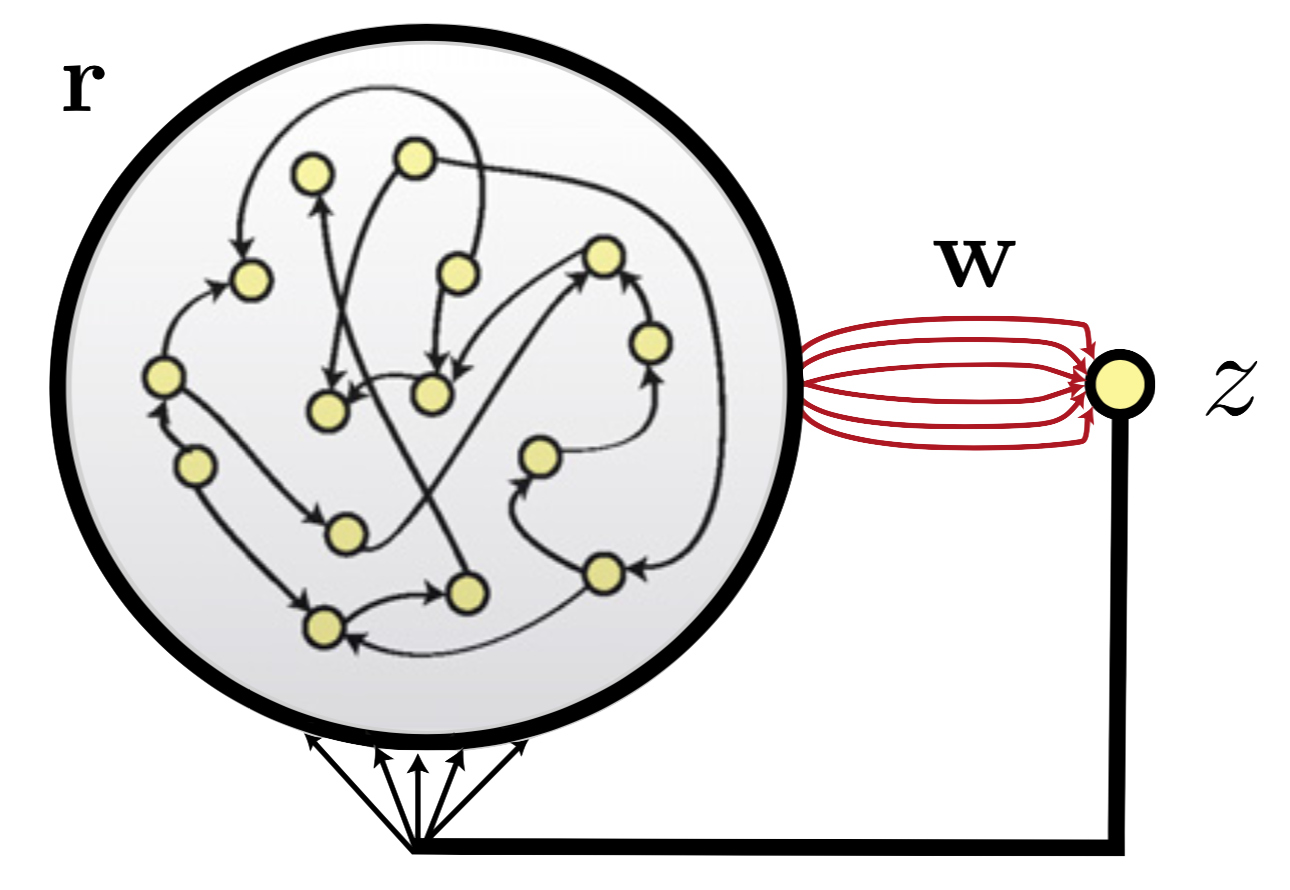Network Architecture A¶
-
chaotic_neural_networks.networkA.N_G= 1000¶ Generator Network – Number of neurons
-
class
chaotic_neural_networks.networkA.NetworkA(N_G=1000, p_GG=0.1, g_GG=1.5, g_Gz=1.0, f=<numpy.lib.function_base.vectorize object>, dt=0.1, Δt=1.0, α=1.0, τ=10.0, seed=1, nb_outputs=1)[source]¶ Neural Architecture A:
-
FORCE_sequence(t_max, number_neurons=5)[source]¶ Returns a matplotlib figure of a full FORCE training sequence, showing the evolution of:
- network ouput(s)
number_neuronsneurons membrane potential- and the time-derivative of the readout vector \(\dot{\textbf{w}}\)
before training (spontaneous activity), throughout training, and after training (test phase): each one of these phases lasts
t_max/3.See
training_sequence_plots.pyin the github repository for further examples.Examples
>> network = networkA.NetworkA(f=utils.periodic); network.FORCE_sequence(600) Pre-training / Spontaneous activity… Training… > Average Train Error: [ 0.02805716] Testing… > Average Test Error: [ 2.50709125]
-
error(train_test='train')[source]¶ Compute the average training/testing error.
Parameters: train_test ({'PCA', 'MDA'}, optional) – Choice of the error to compute: train or test. Returns: Train of test error, depending on train_test Return type: (len(self.z_list),) array
-
step(train_test='train', store=True)[source]¶ Execute one time step of length
dtof the network dynamics.Parameters: train_test ({'PCA', 'MDA'}, optional) – Learning phase (when \(P\) and the readout unit are updated) or test phase (no such update) Examples
>>> from chaotic_neural_networks import networkA; net = networkA.NetworkA() >>> for _ in np.arange(0, 1200, net.dt): ... net.step() >>> net.error() 0.015584795078446064
-
-
chaotic_neural_networks.networkA.dt= 0.1¶ Network integration time step.
-
chaotic_neural_networks.networkA.g_GG= 1.5¶ Scaling factor of the connection synaptic strength matrix of the generator network. $$g_{GG} > 1 ⟹ ext{chaotic behavior}$$
-
chaotic_neural_networks.networkA.g_Gz= 1.0¶ Scaling factor of the feedback loop – Increasing the feedback connections result in the network chaotic activity allowing the learning process.
-
chaotic_neural_networks.networkA.p_GG= 0.1¶ Generator Network – sparseness parameter of the connection matrix. Each coefficient thereof is set to \(0\) with probability \(1-p_{GG}\).
-
chaotic_neural_networks.networkA.p_z= 1.0¶ Sparseness parameter of the readout – a random fraction \(1-p_z\) of the components of \(\mathbf{w}\) are held to \(0\).
-
chaotic_neural_networks.networkA.Δt= 1.0¶ Time span between modifications of the readout weights – \(Δt ≥ dt\)
-
chaotic_neural_networks.networkA.α= 1.0¶ Inverse Learning rate parameter – \(P\), the estimate of the inverse of the network rates correlation matrix plus a regularization term, is initialized as $$P(0) = \frac 1 α \mathbf{I}$$
So a sensible value of \(α\) - depends on the target function - ought to be chosen such that \(α << N\)
If - \(α\) is too small ⟹ the learning is so fast it can cause unstability issues. - \(α\) is too large ⟹ the learning is so slow it may fail
-
chaotic_neural_networks.networkA.τ= 10.0¶ Time constant of the units dynamics.
